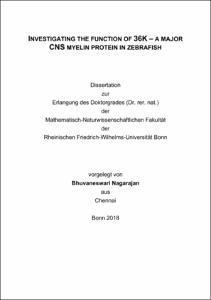Investigating the function of 36K – a major CNS myelin protein in zebrafish

Investigating the function of 36K – a major CNS myelin protein in zebrafish

| dc.contributor.advisor | Odermatt, Benjamin | |
| dc.contributor.author | Nagarajan, Bhuvaneswari | |
| dc.date.accessioned | 2020-04-26T10:16:13Z | |
| dc.date.available | 2020-04-26T10:16:13Z | |
| dc.date.issued | 14.02.2019 | |
| dc.identifier.uri | https://hdl.handle.net/20.500.11811/7865 | |
| dc.description.abstract | Zebrafish can regenerate and remyelinate CNS axons following injury in contrast to humans and other mammals. Common myelin proteins like Mbp, Plp1/DM20 are conserved across species from zebrafish to humans. In addition to the conserved myelin proteins, there are other major myelin proteins like ClaudinK, Zwilling, 36K identified in teleosts. 36K is one of the most abundant CNS myelin proteins in zebrafish brain while it is absent as protein in mammals. Despite the abundance, its function remains unknown. Understanding the function of 36K during development is essential to study the function during remyelination. This study focusses on investigating the function of 36K during development in zebrafish. Translation blocking Morpholinos have been designed to address the function by knocking down the expression of 36K. 36K knockdown larvae have reduced body-length, disrupted myelin and fewer differentiated OPCs. The phenotypes could be rescued when 36k mRNA was co-injected with the Morpholino, suggesting the specificity of the Morpholino. With a mRNA microarray analysis, an upregulation of Notch targets has been found in 36K knockdown larvae. Further confirming that 36K acts on oligodendrocyte precursor cells through Notch, the phenotypes could be rescued in 36K knockdown larvae when treated with a gamma secretase inhibitor. This inhibitor indirectly inhibits Notch, by preventing the release of Notch intracellular domain, the step crucial for Notch activation. As 36K belongs to the short chain dehydrogenase family and is present in cell membrane, we further hypothesised that 36K alters membrane lipids and hence regulates the activity of gamma secretase. Thin layer chromatography and liquid chromatography-mass spectrometry experiments could confirm alteration in lipids in 36K knockdown larvae. In summary, 36K regulates membrane lipid composition and hence activity of gamma secretase and Notch ligands. This in turn has an influence on Notch activity and oligodendrocyte differentiation and hence myelination. Further studies will have to be carried out to investigate the role of 36K in compact myelin as well as its role on OPC differentiation during remyelination, which might help in developing potential strategies for remyelination in humans. | en |
| dc.language.iso | eng | |
| dc.rights | In Copyright | |
| dc.rights.uri | http://rightsstatements.org/vocab/InC/1.0/ | |
| dc.subject.ddc | 570 Biowissenschaften, Biologie | |
| dc.title | Investigating the function of 36K – a major CNS myelin protein in zebrafish | |
| dc.type | Dissertation oder Habilitation | |
| dc.publisher.name | Universitäts- und Landesbibliothek Bonn | |
| dc.publisher.location | Bonn | |
| dc.rights.accessRights | openAccess | |
| dc.identifier.urn | https://nbn-resolving.org/urn:nbn:de:hbz:5n-53489 | |
| ulbbn.pubtype | Erstveröffentlichung | |
| ulbbnediss.affiliation.name | Rheinische Friedrich-Wilhelms-Universität Bonn | |
| ulbbnediss.affiliation.location | Bonn | |
| ulbbnediss.thesis.level | Dissertation | |
| ulbbnediss.dissID | 5348 | |
| ulbbnediss.date.accepted | 31.01.2019 | |
| ulbbnediss.institute | Mathematisch-Naturwissenschaftliche Fakultät : Fachgruppe Biologie / Institut für Genetik | |
| ulbbnediss.fakultaet | Mathematisch-Naturwissenschaftliche Fakultät | |
| dc.contributor.coReferee | Kubitscheck, Ulrich |
Files in this item
This item appears in the following Collection(s)
-
E-Dissertationen (4163)




